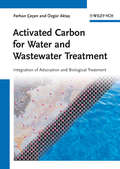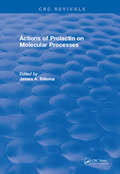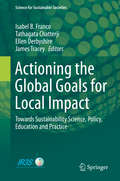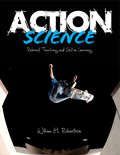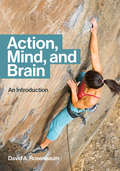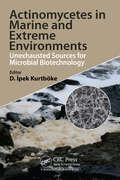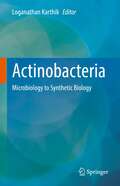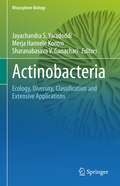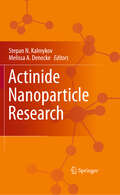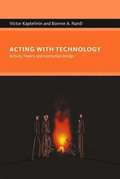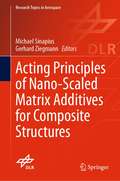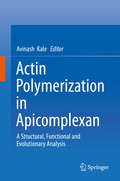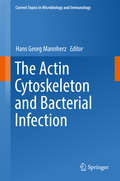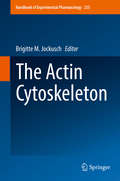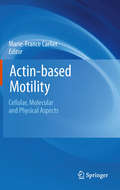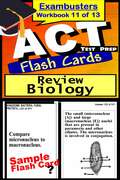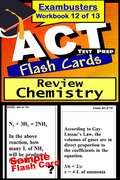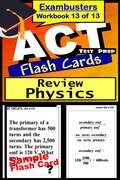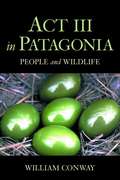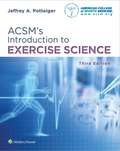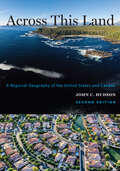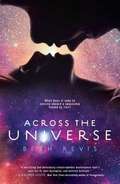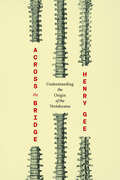- Table View
- List View
Activated Carbon for Water and Wastewater Treatment: Integration of Adsorption and Biological Treatment
by Ferhan Cecen Özgür AktasThis monograph provides comprehensive coverage of technologies which integrate adsorption and biological processes in water and wastewater treatment. The authors provide both an introduction to the topic as well as a detailed discussion of theoretical and practical considerations. After a review of the basics involved in the chemistry, biology and technology of integrated adsorption and biological removal, they discuss the setup of pilot- and full-scale treatment facilities, covering powdered as well as granular activated carbon. They elucidate the factors that influence the successful operation of integrated systems. Their discussion on integrated systems expands from the effects of environmental to the removal of various pollutants, to regeneration of activated carbon, and to the analysis of such systems in mathematical terms. The authors conclude with a look at future needs for research and develoment. A truly valuable resource for environmental engineers, environmental and water chemists, as well as professionals working in water and wastewater treatment.
Actions of Prolactin On Molecular Processes
by James A. RillemaIt is well established tht the intial interaction of prolactin with its target cells is with specific receptor molecules located on the external surface of the plasma membrane. Subsequent to the prolactin-receptor interaction, however, the molecular events that culminate in the regulation of biological processes are not totally understood. This book was assembled to review and analyse the currently available information relative to the molecular events involved in the actions of prolactin on cells. Hopefully, the assimilation of this information will provide the basis for ultimately determining the sequence of molecular reactions by which prolactin expresses its biological responses.
Actioning the Global Goals for Local Impact: Towards Sustainability Science, Policy, Education and Practice (Science for Sustainable Societies)
by Isabel B. Franco Tathagata Chatterji Ellen Derbyshire James TraceyThis book highlights the value of sustainability science in newly emerging and innovative approaches to research, education, capacity building and practice in order to transform rhetoric into impact sustainability. Presenting case studies from various industries, sectors and geographical contexts targeting the seventeen (Sustainable development Goals (SDGs) outlined in the 2030 Agenda, it provides insightful recommendations to create sustainable impact while at the same time achieving the global goals. The book addresses the fundamental question of how sustainability rehtoric can be transformed into impact sustainability research, education and capacity building and as a result, how existing approaches in science, curricula and practice are mitigating the demands emerging from addressing global sustainable development in an impactful and innovative manner. Providing recommendations for impact sustainability in science, curriculum on how to address pressing sustainability issues and contribute toward achieving the SDGs, this book is an essential reference for both academics and professionals.
Action Science: Relevant Teaching and Active Learning
by William H. RobertsonPut student engagement on the fast-track Think action sports like skateboarding and BMX have nothing to do with physical science? Think again, especially as they relate to fundamental physics concepts like motion, force, and simple machines—not to mention the problem solving required. What’s more, because kids will want to, observing action sports is a perfect vehicle for promoting self-directed and collaborative learning . . . with Action Science as your driver’s manual. Through a combination of book and video, Bill Robertson provides all the materials you’ll need to get started, with the NGSS very much in full view. Inside and outside, you’ll find: Detailed instructional methods on momentum, center of gravity, inertia, and centrifugal and centripetal forces Hands-on classroom activities and experiments, including some utilizing common household materials Captivating video via QR codes of top professional and amateur extreme sports athletes demonstrating authentic, high-flying maneuvers Robertson, an associate professor in science and technology education at the University of Texas at El Paso--and an avid skateboarder—has extensively piloted the Action Science program. It works! "This is an outstanding resource for any middle school science teacher trying to engage unmotivated students or implement problem-based learning strategies in a way that is exciting and meaningful!" --Melissa Miller, Middle School Science Teacher Lynch Middle School Farmington, AR
Action Science: Relevant Teaching and Active Learning
by William H. RobertsonPut student engagement on the fast-track Think action sports like skateboarding and BMX have nothing to do with physical science? Think again, especially as they relate to fundamental physics concepts like motion, force, and simple machines—not to mention the problem solving required. What’s more, because kids will want to, observing action sports is a perfect vehicle for promoting self-directed and collaborative learning . . . with Action Science as your driver’s manual. Through a combination of book and video, Bill Robertson provides all the materials you’ll need to get started, with the NGSS very much in full view. Inside and outside, you’ll find: Detailed instructional methods on momentum, center of gravity, inertia, and centrifugal and centripetal forces Hands-on classroom activities and experiments, including some utilizing common household materials Captivating video via QR codes of top professional and amateur extreme sports athletes demonstrating authentic, high-flying maneuvers Robertson, an associate professor in science and technology education at the University of Texas at El Paso--and an avid skateboarder—has extensively piloted the Action Science program. It works! "This is an outstanding resource for any middle school science teacher trying to engage unmotivated students or implement problem-based learning strategies in a way that is exciting and meaningful!" --Melissa Miller, Middle School Science Teacher Lynch Middle School Farmington, AR
Action, Mind, and Brain: An Introduction
by David A. RosenbaumAn engaging and accessible introduction to the psychology and neuroscience of physical action.This engaging and accessible book offers the first introductory text on the psychology and neuroscience of physical action. Written by a leading researcher in the field, it covers the interplay of action, mind, and brain, showing that many core concepts in philosophy, psychology, neuroscience, and technology grew out of questions about the control of everyday physical actions. It explains action not as a &“one-way street from stimuli to response&” but as a continual perception-action cycle. The informal writing style invites students to think through the evidence step by step, helping them develop general thinking stills as well as learn specific facts. Special emphasis is placed on the role of underrepresented groups. The book discusses the intellectual background of the field, from Plato to Kant, Dewey, and others; applications and methods; and the physical substrates of action—bones, tendons, ligaments, muscles, and nerves. It considers the control of actions in space; learning, and the roles of nature and nurture; feedback; feedforward, or anticipated feedback; and degrees of freedom—the multiple ways of getting things done and three methods for narrowing the alternatives. The book is generously illustrated, including many images of thinkers who contributed to the field.
Actinomycetes in Marine and Extreme Environments: Unexhausted Sources for Microbial Biotechnology
by D. İpek KurtbökeThe discovery and development of antibiotics has been one of the most significant advances in medicine. In a golden era lasting from the 1940s to the late 1960s, antibiotic research provided mankind with a wide range of structurally diverse and effective agents for the treatment of microbial infections. Since then, actinomycetes, most notably members of the genus Streptomyces, have uninterruptedly proved to be a particularly rich source of antibiotics and other therapeutic and biotechnologically important compounds. This book brings together expert actinomycetologists to communicate the importance of finding novel antibiotic producing actinomycetes in extreme and marine environments in the light of molecular advances.
Actinobacteria: Microbiology to Synthetic Biology
by Loganathan KarthikThis book summarizes the basics of actinobacteria, from microbiology to synthetic biology. It focuses on diversity, NRPS, sesquiterpenes, lantipeptide, bioinformatics apparatuses, cloning, CRISPR, reverse engineering, FDA supported medications, and marine actinobacteria. It also covers the latest trends in drug discovery from actinobacteria, and introduces several recently developed bioinformatics and synthetic biology tools to explore new antibiotics from actinobacteria. Many natural products such as polyketides, isoprenoids, phenazines, peptides, indolocarbarbazoles, sterols, and others have been isolated and characterized from actinobacteria. Some products are synthesized by the non-ribosomal peptide synthetases (NRPSs), polyketide synthases (PKSs), or other functional genes. Although genome sequencing has uncovered the differing qualities of these chemicals, recognizing new items and their biosynthetic pathways is still under examination.Cryptic metabolic pathways have been explored using molecular techniques or culture-dependent approaches. In recent years, researchers’ primary interest is to identify the specific conditions or agents that wake the cryptic antibiotics. Several bioinformatics and synthetic biology tools were developed to explore new antibiotics from actinobacteria.The book comprises 14 chapters with different aspects of application and utilization of actinomycetes from the microbiology; systems biology, pharmacology of natural products, bioinformatics, actinomycete and its diversity, CRISPR, artificial Intelligence, synthetic biology, metabolic engineering, expressional studies, and biosynthetic gene clusters. The book delivers useful information on actinomyces to researchers, novices in genome designing, specialists, clinicians, policymakers, and professionals.
Actinobacteria: Ecology, Diversity, Classification and Extensive Applications (Rhizosphere Biology)
by Jayachandra S. Yaradoddi Merja Hannele Kontro Sharanabasava V. GanachariThrough this book, the readers will learn about the different aspects of Actinobacteria- beginning with its ecology and occurrence, to the ways of its adaptation to harsh climates, and finally to its practical applications. The book also presents methods of identifying and characterizing this diverse group of bacteria through advanced techniques like MALDI-TOF, 16S rRNA analysis, etc. Different chapters describe the various biotechnological applications of Actinobacteria, including bioremediation, secondary metabolite production, and in producing antibiotics, anti-cancer therapeutics. It also provides insights into the applications in agriculture and forestry by inhibiting plant pathogenic bacteria's growth.
Actinide Nanoparticle Research
by Melissa A. Denecke Stepan N. KalmykovThis is the first book to cover actinide nano research. It is of interest both for fundamental research into the chemistry and physics of f-block elements as well as for applied researchers such as those studying the long-term safety of nuclear waste disposal and developing remediation strategies. The authors cover important issues of the formation of actinide nano-particles, their properties and structure, environmental behavior of colloids and nanoparticles related to the safe disposal of nuclear wastes, modeling and advanced methods of characterization at the nano-scale.
Acting with Technology: Activity Theory and Interaction Design
by Victor Kaptelinin Bonnie A. NardiActivity theory holds that the human mind is the product of our interaction with people and artifacts in the context of everyday activity. Acting with Technology makes the case for activity theory as a basis for understanding our relationship with technology. Victor Kaptelinin and Bonnie Nardi describe activity theory's principles, history, relationship to other theoretical approaches, and application to the analysis and design of technologies. The book provides the first systematic entry-level introduction to the major principles of activity theory. It describes the accumulating body of work in interaction design informed by activity theory, drawing on work from an international community of scholars and designers. Kaptelinin and Nardi examine the notion of the object of activity, describe its use in an empirical study, and discuss key debates in the development of activity theory. Finally, they outline current and future issues in activity theory, providing a comparative analysis of the theory and its leading theoretical competitors within interaction design: distributed cognition, actor-network theory, and phenomenologically inspired approaches.
Acting Principles of Nano-Scaled Matrix Additives for Composite Structures (Research Topics in Aerospace)
by Michael Sinapius Gerhard ZiegmannThe book explores the effect of nanoscale matrix additives along the four levels of material formation, particle-resin interaction, the influence of nanoparticles on the processability of the polymer, the influence of nanoparticles on polymer curing and the influence of nanoparticles on the fiber plastic composite. Fiber-reinforced plastics have a significantly higher lightweight construction potential in components with a primary single- or biaxial stress state compared to isotropic metals. At the same time, their insensitivity to corrosion and their advantageous fatigue properties can help to reduce maintenance costs. Due to their outstanding specific mechanical properties, they are among today's high-performance lightweight construction materials. These properties make them particularly attractive in the field of mobility. However, as soon as the matrix properties dominate the mechanical properties, e.g. in the case of fibre-parallel compressive strength, significant weaknesses become apparent in the mechanical properties. Here, one approach is to significantly increase the matrix properties through nanoscale ceramic additives and at the same time to guarantee the processability of the resin.
Actin Polymerization in Apicomplexan: A Structural, Functional and Evolutionary Analysis
by Avinash KaleThis book discusses in detail the structural, evolutionary and functional role of actin and its regulatory proteins in gliding motility in apicomplexan organisms, a unique phenomenon found in actin-myosin cytoskeletal elements. The book also explores the potential of different actin regulators, namely formin, profilin, actin depolymerization factor (ADF), capping proteins (CPα and CPβ), cyclase-associated protein (CAP) and coronin 13–24 as potential drug targets against malaria. As the chief components of the gliding motor, the actin-regulator proteins are characterized by unique features that make them promising targets for structure-based drug design. Lastly, the book proposes a mathematical model, based on kinetic data mining, to help understand the most vital regulators for actin polymerization dynamics.
The Actin Cytoskeleton and Bacterial Infection
by Hans Georg MannherzThis volume describes the mechanisms which bacteria have created to secure their survival, proliferation and dissemination by subverting the actin cytoskeleton of host cells. Bacteria have developed a veritable arsenal of toxins, effector proteins and virulence factors that allow them to modify the properties of the intracellular actin cytoskeleton for their own purposes. Bacterial factors either modify actin directly as the main component of this part of the cytoskeleton or functionally subvert regulatory or signalling proteins terminating at the actin cytoskeleton. In short, this volume provides an overview of the various tricks bacteria have evolved to "act on actin" in order to hijack this essential host cell component for their own needs. As such, it will be of interest to scientists from many fields, as well as clinicians whose work involves infectious diseases.
The Actin Cytoskeleton
by Brigitte M. JockuschActin is one of the most abundant proteins and ubiquitously expressed in all eukaryotes. In recent years, the analysis of structure and function of such complexes has shed new light on actin's role in cellular and tissue morphogenesis, locomotion and various forms of intracellular motility, but also on its role in nuclear processes like chromatin architecture and transcription. Progress in understanding these different physiological phenomena, but also in unravelling the basis of actin-based pathophysiological processes has been made by combining video microscopy, molecular biology, genetics and biochemistry. Thus, the current research on actin, as ongoing in many international laboratories, is a "hot spot" in basic and translational research in life sciences. In this book on "The Actin Cytoskeleton", twelve internationally renowned authors present specific chapters that cover their recent work concerned with the various roles of actin mentioned above. This comprehensive volume is therefore an attractive handbook for teachers and students in many fields of medicine and pharmacology.
Actin-based Motility: Cellular, Molecular and Physical Aspects
by Marie-France CarlierThis book presents the cellular, molecular and physical aspects of production of force and movement by self-assembly of actin, one of the most abundant protein in cells, into cytoskeletal filaments. « Actin-based motile processes » are responsible for a very large variety of motile activities of cells in their physiological and pathological states, covering chemotactic locomotion, embryonic and metastatic cell migration, wound healing, eukaryotic cytokinesis and bacterial plasmid segregation, endocytic and phagocytic activities, as well as morphogenetic processes like axis patterning in early embryo, axonal growth in brain development, immune response and synaptic plasticity processes at the origin of learning and memory. The different chapters of the book describe how the multidisciplinary multiscale approaches taken in the recent years have explored the molecular and physical mechanisms at the origin of force and movement produced by actin self-assembly. The chosen topics show how advances have been made in the field of cell motility due to progress in live cell imaging, light microscopy, improved resolution in the structure of large protein assemblies, biochemical analysis and mathematical modeling of actin assembly dynamics and development of nanotechnologies allowing to measure forces in the range of pico- to nano-newton produced by actin assemblies.
ACT Test Prep Flash Cards: Biology Review (Exambusters ACT Workbook #11 of 13)
by Ace Inc.450 questions. Topics: Cells, Biochemistry and Energy, Evolution, Kingdoms: Monera, Fungi, Protista, Plants, Animals; Human: Locomotion, Circulation, Immunology, Respiration, Excretion, Digestion, Nervous System <P><P><i>Advisory: Bookshare has learned that this book offers only partial accessibility. We have kept it in the collection because it is useful for some of our members. Benetech is actively working on projects to improve accessibility issues such as these.</i><P><P>
ACT Test Prep Flash Cards: Chemistry Review (Exambusters Workbook #12 of 13)
by Ace Inc.700 questions. Essential chemistry formulas and concepts.<P><P> Topics: Metric System, Matter, Atoms, Formulas, Moles, Reactions, Elements, Chemical Bonds, Phase Changes, Solutions, Reaction Rates, Acids and Bases, Oxidation and Reduction, Introduction to Organic Chemistry. <P><P><i>Advisory: Bookshare has learned that this book offers only partial accessibility. We have kept it in the collection because it is useful for some of our members. Benetech is actively working on projects to improve accessibility issues such as these.</i><P><P>
ACT Test Prep Flash Cards: Physics Review (Exambusters Workbook #13 of 13)
by Ace Inc.600 questions. Sample problems. Topics: Metric System, Motion and Forces, Work and Energy, Fluids, Sound, Light and Optics, Static Electricity, D.C. and A.C. Circuits, Magnetism. <P><P><i>Advisory: Bookshare has learned that this book offers only partial accessibility. We have kept it in the collection because it is useful for some of our members. Benetech is actively working on projects to improve accessibility issues such as these.</i><P><P>
Act III in Patagonia: People and Wildlife
by William ConwayFrom tracking elephant seals in the Atlantic to following flamingos in the Andes, Act III in Patagonia takes readers to the sites where real-life field science is taking place. It further illuminates the ecology of the region through a history that reaches from the time of the Tehuelche Indians known by Magellan, Drake, and Darwin to the present.
Acsm's Introduction To Exercise Science
by Jeffrey A. Potteiger<P>Succeed in your course and learn more about potential careers with ACSM's Introduction to Exercise Science, 3rd Edition.<P> This proven book provides an engaging, up-to-date overview of exercise science and related areas, such as athletic training and sports medicine.<P> In every chapter, the author illustrates the importance and clinical relevance of each topic in the curriculum and gives you an insider's view of the profession through fascinating interviews and online video profiles and fieldtrips.<P> As an American College of Sports Medicine publication, this full-color resource offers the unsurpassed quality and excellence that has become synonymous with titles by the leading exercise science and sports medicine organization in the world.<P> NEW! A brand-new chapter shows how research is conducted, provides an overview of research as a career pursuit, and explores the concept of evidence-base practice.<P> Video fieldtrips take you into different real-world settings to learn about exercise science careers.<P> UPDATED! Interviews and video profiles of rising stars in the exercise science profession and working healthcare professionals (a dietician, cardiologist, exercise physiologist, etc.) demonstrate the challenges and rewards of careers that begin with an exercise science degree. UPDATED! The "Future of Exercise Science" chapter now reflects the latest trends in the field.<P> Features important updates related to the 10th edition of ACSM's Guidelines for Exercise Testing and Prescription.<P> REVISED! The motor behavior chapter is now more meaningful, relevant, up-to-date, and understandable.<P> Chapter objectives, key terms and definitions, chapter summaries, and Thinking Critically boxes help you master key concepts.
ACRP Report 63: Measurement of Gaseous HAP Emissions from Idling Aircraft as a Function of Engine and Ambient Conditions
by Transportation Research BoardThe findings of this project are summarized as follows:<P><P> 1. Temperature dependence: VOC emission indices are approximately twice as high under cold conditions (-8°C to 0°C) as they are at 15°C for the CFM56-7B24.<P> 2. Fuel flow rate dependence: For the engine states that are likely to be most representative of the operational aircraft taxiway engine state, the VOC emission indices for the CFM56-7B24 are approximately 40% greater than the ICAO certification engine state (7% thrust).<P> 3. VOC speciation: The composition profile of the exhaust is constant. The ratios of individual VOCs (e.g., formaldehyde to 1,3-butadiene) remain constant over all thrust settings and temperatures encountered. The first two findings are thus expected to be applicable to all VOCs measured, with the exception that there is a dependence of benzene emissions on fuel aromatic content.
Across This Land: A Regional Geography of the United States and Canada (Creating the North American Landscape)
by John C. HudsonA fascinating overview of the lands and peoples of the United States and Canada, both past and present.Based on decades of research and written in clear, concise prose by one of the foremost geographers in North America, John C. Hudson's Across This Land is a comprehensive regional geography of the North American continent. Dividing the terrain into ten regions, which are then subdivided into twenty-seven smaller areas, Hudson's brisk narrative reveals the dynamic processes of each area's distinctive place-specific characteristics. Focusing on how human activities have shaped and have been shaped by the natural environment, Hudson considers physical, political, and historical geography. He also highlights related topics, including resource exploitation, economic development, and population change. Praised in its first edition as a readable and reliable interpretation of United States and Canadian geography, the revised Across This Land retains these strengths while adding substantial new material. Incorporating the latest available population and economic data, this thoroughly updated edition includes• reflections on new developments, such as resource schemes, Native governments in Atlantic Canada, and the role of climate change in the Arctic• a new section focused on the US Pacific insular territories west of Hawaii• evolving views of oil and gas production resulting from the introduction of hydraulic fracturing• revised text and maps involving agricultural production based on the 2017 Census of Agriculture• current place names• more than 130 photographsThe most extensive regional geography of the North American continent on the market, Hudson's Across This Land will continue as the standard text in geography courses dealing with Canada and the United States, as well as a popular reference work for scholars, students, and lay readers.
Across the Universe (Across the Universe, Book #1)
by Beth RevisA love out of time. A spaceship built of secrets and murder. Seventeen-year-old Amy joins her parents as frozen cargo aboard the vast spaceship Godspeed and expects to awaken on a new planet, three hundred years in the future. Never could she have known that her frozen slumber would come to an end fifty years too soon and that she would be thrust into the brave new world of a spaceship that lives by its own rules. Amy quickly realizes that her awakening was no mere computer malfunction. Someone - one of the few thousand inhabitants of the spaceship - tried to kill her. And if Amy doesn't do something soon, her parents will be next. Now Amy must race to unlock Godspeed's hidden secrets. But out of her list of murder suspects, there's only one who matters: Elder, the future leader of the ship and the love she could never have seen coming.
Across the Bridge: Understanding the Origin of the Vertebrates
by Henry GeeOur understanding of vertebrate origins and the backbone of human history evolves with each new fossil find and DNA map. Many species have now had their genomes sequenced, and molecular techniques allow genetic inspection of even non-model organisms. But as longtime Nature editor Henry Gee argues in Across the Bridge, despite these giant strides and our deepening understanding of how vertebrates fit into the tree of life, the morphological chasm between vertebrates and invertebrates remains vast and enigmatic. As Gee shows, even as scientific advances have falsified a variety of theories linking these groups, the extant relatives of vertebrates are too few for effective genetic analysis. Moreover, the more we learn about the species that do remain—from sea-squirts to starfish—the clearer it becomes that they are too far evolved along their own courses to be of much use in reconstructing what the latest invertebrate ancestors of vertebrates looked like. Fossils present yet further problems of interpretation. Tracing both the fast-changing science that has helped illuminate the intricacies of vertebrate evolution as well as the limits of that science, Across the Bridge helps us to see how far the field has come in crossing the invertebrate-to-vertebrate divide—and how far we still have to go.
